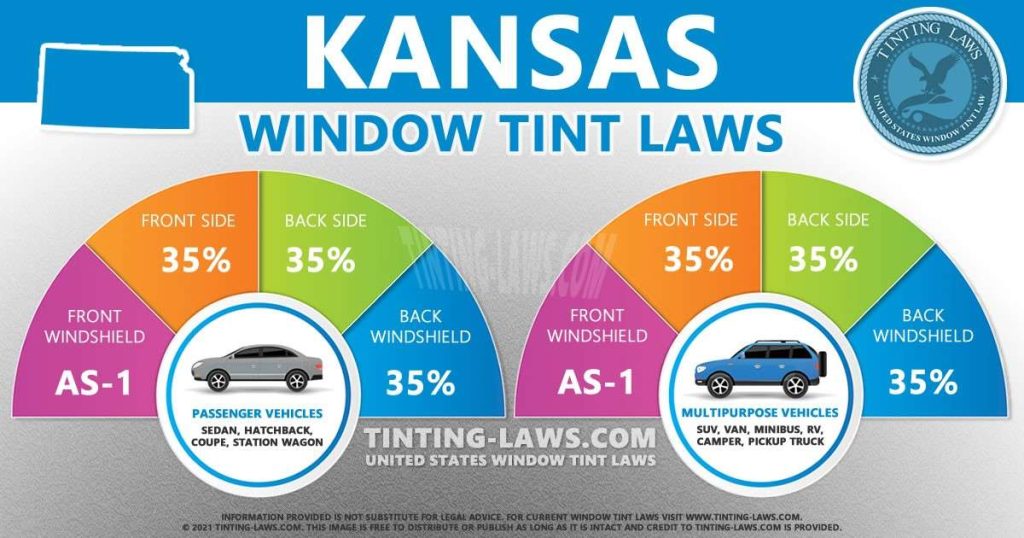Kansas Window Tinting Laws
Car window tinting laws in Kansas were enacted in 1987.
We have provided all the necessary information about your car’s window tint, including how dark or reflective the tint is allowed in your state.
There are also additional car window tinting rules and regulations in Kansas so make sure you read all about it below.
Window tint darkness in Kansas
The percent of visible light allowed through your car windows is called VLT: Visible Light Transmission.
The percentage of light allowed through your film and glass in Kansas is very specific and different for sedan cars and SUV cars or vans.
Tint darkness for sedans:
- Windshield: Non-reflective tint is allowed above the manufacturer’s AS-1 line.
- Front Side windows: Must allow more than 35% of light in.
- Back Side windows: Must allow more than 35% of light in.
- Rear Window: Must allow more than 35% of light in.
Tint darkness for SUV and vans:
- Windshield: Non-reflective tint is allowed above the manufacturer’s AS-1 line.
- Front Side windows: Must allow more than 35% of light in.
- Back Side windows: Must allow more than 35% of light in.
- Rear Window: Must allow more than 35% of light in.
Window tint reflection in Kansas
Window tint can reflect incoming light and reduce glare and heat.
Kansas window tint law permits a certain window reflection when using a tint so make sure you pay attention to this as well.
Tint reflection for sedans:
- Front Side windows: No metallic or mirrored appearance.
- Back Side windows: No metallic or mirrored appearance.
Tint reflection for SUV and vans:
- Front Side windows: No metallic or mirrored appearance.
- Back Side windows: No metallic or mirrored appearance.
Other Kansas window tint rules and regulations:
Kansas does have several other important laws, rules and regulations pertaining to window tinting. They include the following:
- Side Mirrors: Dual side mirrors are required if back window is tinted.
- Restricted Colors: RED, AMBER and YELLOW colors are not allowed.
- Certificates: Manufacturers of film are not required to certify the film they sell in Kansas state.
- Stickers: State law recommends but does not require stickers to identify legal tinting.
- Medical Exceptions: Kansas law does NOT allow medical exemptions that would allow you use special tint.
- Penalties: Class C misdemeanor.
Keep in mind that Kansas tinting laws and regulations may be interpreted differently in your county or place of residence.
We always recommend double-checking our information with your local DMV or law enforcement authorities.

Our information about window tint laws in Kansas was last updated in 2024.
Tinting laws in Kansas were enacted in 1987.
In case any of our info provided is not up to date or correct be sure to contact us so we can fix it. Thanks!
Trusted industry leader in providing accurate window tint laws. Share with confidence:
State of Kansas Info
Kansas is a U.S. state located in the Midwestern United States.
It is named after the Kansa Native American tribe, which inhabited the area.
The tribe’s name (natively kką:ze) is often said to mean “people of the wind” or “people of the south wind,” although this was probably not the term’s original meaning.

Kansas is one of the most productive agricultural states, producing high yields of wheat, sorghum and sunflowers.
Kansas is the 15th most extensive and the 33rd most populous of the 50 United States.
Capital: Topeka
Population: 2,885,905
Area: 82,277 sq mi (213,096 km2)
Cities in Kansas: Wichita, Topeka, Overland Park, Olathe, Kansas City, Lawrence, Manhattan, Lenexa, Dodge City, Salina, Shawnee, Hays, Leawood, Emporia, Hutchinson, Leavenworth, Junction City, Liberal, Prairie Village, Garden City, Pittsburg, Abilene, Atchison, Eudora, Coffeyville, Merriam, Great Bend, Gardner, Everest, Newton, Oakley, Mission, Delphos, Bonner Springs, El Dorado, Smith Center, Shawnee Mission, Stull, Arkansas City, Fort Scott, Chanute, Scott City, Ottawa, Independence, Greensburg, Lindsborg, McPherson, Andale, Colby, Winfield
Counties in Kansas: Allen, Anderson, Archison, Barber, Barton, Bourbon, Brown, Butler, Chase, Chautauqua, Cherokee, Cheyenne, Clark, Clay, Cloud, Coffey, Comanche, Cowley, Crawford, Decatur, Dickinson, Doniphan, Douglas, Edwards, Elk, Ellis, Ellsworth, Finney, Ford, Franklin, Geary, Gove, Graham, Grant, Gray, Greeley, Greenwood, Hamilton, Harper, Harvey, Haskell, Hodgeman, Jackson, Jefferson, Jewell, Johnson, Kearny, Kingman, Kiowa, Labette, Lane, Leavenworth, Lincoln, Linn, Logan, Lyon, Marion, Marshall, McPherson, Meade, Miami, Mitchell, Montgomery, Morris, Morton, Nemaha, Neosho, Ness, Norton, Osage, Osborne, Ottawa, Pawnee, Phillips, Pottawatomie, Pratt, Rawlins, Reno, Republic, Rice, Riley, Rooks, Rush, Russell, Saline, Scott, Sedgwick, Seward, Shawnee, Sheridan, Sherman, Smith, Stafford, Stanton, Stevens, Sumner, Thomas, Trego, Wabaunsee, Wallace, Washington, Wilson, Woodson, Wyandotte
Tint law references:
Kansas Statutes Chapter 8 Article 17: se Cections 8-1749a through 8-1749c